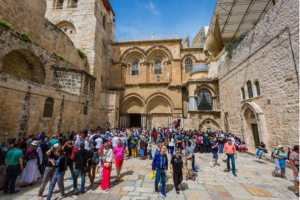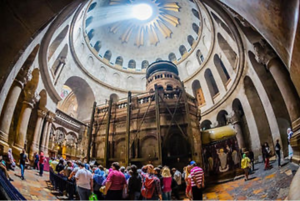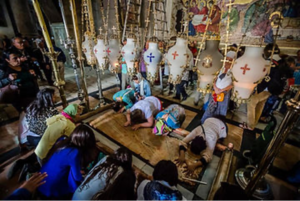In the early morning hours of the Jewish Sabbath, there is a calming stillness that lingers over the city of Jerusalem. At the western wall of the temple mount you can hear the chorus of singing birds, worshippers pining to be near God, and, if you use your imagination, you can even hear the sound of human hearts yearning to transcend this earthly existence. As you make your way to the famed church of the Holy Sepulcher, you can hear the sound of pilgrims with their excited voices and hurried steps, longing to walk where Jesus walked— longing to give their heartfelt honor to a man who so lovingly sacrificed himself for the good of others. Many of those visitors approach the site with a desire to touch the rock where tradition says the body of Jesus once laid in preparation for his burial. Others come looking for answers and yearning to connect with God while they visit the shrine, which contains the remnants of an ancient grave where it is alleged that our Lord was once entombed. 
When I first visited the Church of the Holy Sepulcher some twenty-five years ago, I felt little connection or excitement about this dark and medieval-looking place. All I could see at that time were religious practices foreign to the Bible. I saw idolatry and an ancient building constructed centuries after the time of Jesus. But over the years—I have come to see this place in a different way. Archaeology and tradition have made a compelling case that the site upon which this historic building stands may very well be the actual site where Jesus was crucified and buried. The steps just inside the entrance
of this iconic building led to an enshrined rocky hill that, during the time of Jesus, was situated just outside the city wall and not far from one of the nearby gates or entrances of the city.
Adjacent to the Edicule (or alleged place of his burial), there is a room that leads to several first-century burial chambers, a perfect location near the crucifixion site where one might need to hurriedly bury a friend with the start of the sabbath so quickly approaching (John 19:38-42). Beneath the building, evidence has been discovered revealing that the location had also been used as a first-century place of agriculture and gardening. So, from the standpoint of the central doctrine of the Christian faith, this makes the church of the Holy Sepulcher a highly fascinating place to visit.
But this ancient church building is important for another reason. What I saw at the Church of the Holy Sepulcher changed me. As you walk through its dimly lit corridors and stop to consider its distinctive architecture, its stunning mosaics and art, and its walls so riddled with the marks of a tumultuous and bloody past, I began to see its significance in human terms. This place stands as a monument where men and women of history fought and died to preserve its heritage and meaning. This old building and the earth beneath its foundation have a long and storied history that testifies to the hearts of others–hearts that have longed to be near the place where they believe Jesus purchased their redemption and so willingly sacrificed himself on their behalf.

The place where hundreds of thousands visit each year tells the story of people, souls that will one day inhabit eternity.
Today, those who visit the Church of the Holy Sepulcher do so for a variety of reasons. Some out of curiosity, others as students of history. Many others, however, do so for the purpose of finding forgiveness and are yearning to connect with God. While their religious practices are often misguided, their intent is to be praised. With all the false religions and philosophies extant in the world, I can’t help but be encouraged to know that there are people who are still seeking to be near our Savior. Today, when I observe visitors at the Church of the Holy Sepulcher, I try not to be overcome with disdain over the unbiblical practices observed inside nor sneer over the vain worship practiced there. Instead, through the odor of smoking oil lamps and the burning of incense, I have begun to observe the unmistakable fragrance of people, people with souls who want to know more about Jesus. And, by means of the flickering candles found burning in a place so filled with darkness, comes the reminder that Christ is the light of men, which shined in darkness, revealing to us through his powerful words the light of a beautiful day. I am also reminded that He is not in some tomb hallowed by men but has risen from the grave and is alive forevermore.
The Church of the Holy Sepulcher is important for several reasons, but none more important than the reminder that there are still many, many souls who are longing to connect with God. Shrines and monuments don’t contain the saving power of Jesus, but the beautiful gospel of Christ does. A gospel that our world so desperately needs to hear. At the tomb where it is alleged our Lord was buried are souls who are longing to know the truth and feel at peace with God. But not only in Jerusalem do souls gather around a tomb longing to know God. Every day throughout our communities’ souls are hurting as they bury their friends and family and, at the same time, are searching for answers and seeking to connect with God. They simply need someone to show them the way, someone like you and someone like me. Let’s do what we can to show them the way.
and someone like me. Let’s do what we can to show them the way.
Bahat, Dan. “Does the Holy Sepulchre Church Mark the Burial of Jesus?” Biblical Archaeology Review 12, no. 3 (1986): 26–45.

